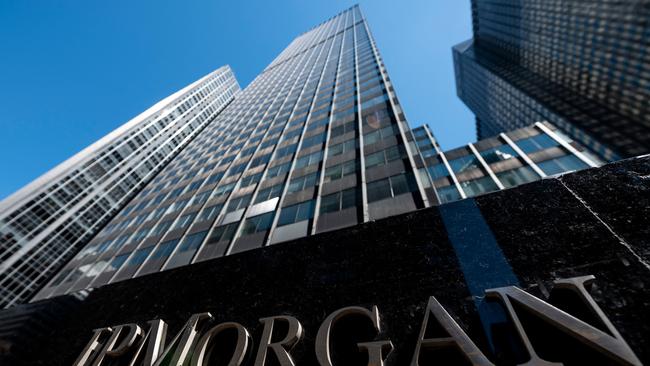JPMorgan profit sinks 42pc after a pandemic boom
The investment bank’s first-quarter profit dropped 42 per cent as it socked away funds to prepare for higher defaults in case of recession.

JPMorgan Chase’s pandemic boom ended with a sharp drop in profits as it issued a warning: Rising inflation and the war in Ukraine pose big threats to the US economy.
Chief executive Jamie Dimon said the economy is strong and growing, citing double-digit growth in card spending, low delinquencies and healthy household and consumer balance sheets.
But the bank also surprised Wall Street by setting aside $US900m ($A1.21bn) in new funds to prepare for economic turmoil; a year ago, it freed up $US5.2bn it had reserved for potential loan losses in the pandemic’s early months.
Those extra funds are there to cushion the bank if the economy tips into recession, sending loan defaults higher. Mr Dimon said that risk remains remote but has grown following Russia’s invasion of Ukraine and as inflation has risen to its highest level in 40 years.
“Those are very powerful forces, and those things are going to collide at one point,” Mr Dimon said. “No one knows what’s going to turn out.” A recession, he said, is far from a sure thing. “Is it possible? Absolutely.” The nation’s biggest bank recorded a profit of $US8.28bn in the first quarter, a 42 per cent decline from a year ago.
Revenue fell 5 per cent to $US30.72bn, ahead of analyst expectations for $US30.59bn, according to FactSet.
JPMorgan shares fell 2.7 per cent to $US128.01 on Wednesday. The stock has now lost about 20 per cent this year, while the S&P 500 is down 7 per cent.
The bank took total credit charges of $US1.5bn. Of the $US900m set aside for potential future losses, about one-third was tied to Russia, Chief Financial Officer Jeremy Barnum said. The rest, he said, is to account for the risk that interest-rate increases by the Federal Reserve could cause the economy to slow too much, resulting in a recession.
Consumer spending on credit cards rose 29 per cent, with a 64 per cent increase in spending on travel and entertainment. Consumers started carrying more debt as well, as credit-card loans increased 15 per cent. Though card loans remain below prepandemic levels, the increase potentially signals that some customers have started to burn through stimulus funds that buffered them throughout the pandemic.
Still, a 15 per cent increase in consumer and small-business deposits indicates that many remain flush with cash.
Losses on consumer loans were just 0.5 per cent of outstanding loans, and there were fewer loans in 30-day and 90-day delinquencies than a year ago.
Rising rates and supply-chain snarls dented other areas of JPMorgan’s consumer operation, which saw total revenue decline in the quarter. Mortgage originations dropped 37 per cent from a year ago, largely due to soaring interest rates on home loans. Auto-loan originations dropped 25 per cent due to a dearth of available vehicles.
A sharp decline in the volume of initial public offerings helped push revenue down 7 per cent and profit down 26 per cent in JPMorgan’s corporate and investment bank.
The unit also took $US524m in losses related to the bank’s commodities and Russia exposure, including $US120m in trading losses tied to nickel. JPMorgan is a top margin lender to Chinese metals giant Tsingshan Holding Group, whose giant short position on nickel plunged when the price of the metal surged after Russia invaded Ukraine.
Total investment-banking fees fell 31 per cent. Equity underwriting sank 76 per cent to its worst quarter in six years.
Trading revenue fell 3 per cent from the year earlier when corporate debt sales, IPOs and an army of individual investors powered a stock-market boom. Fixed-income trading was down 1 per cent and equities trading fell 7 per cent.
Markets will get even choppier in the coming months as the Fed moves to tame inflation, Mr Dimon said. The central bank raised interest rates last month for the first time since 2018, and it is expected to continue to raise rates throughout the year.
“I cannot foresee any scenario at all where you’re not going to have a lot of volatility in markets,” he said. “That could be good or bad for trading, but there’s almost no chance it won’t happen.” Still, higher rates also make lending more profitable, since they allow banks to charge more on loans. The bank’s net interest margin, a measure of what it collects on loans minus what it pays for deposits, rose to 1.67 per cent from 1.63 per cent at the end of December.
Total loans increased 6 per cent, a welcome sign after two years of sluggish loan growth.
The Wall Street Journal


